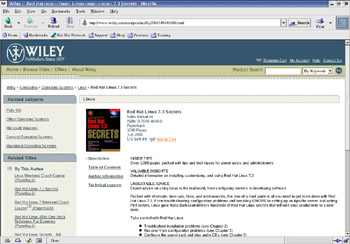Surfing the Net
Surfing the Net
Like anything else, the Web is easier to understand after you have seen how it works. One of the best ways to learn about the Web is to surf it with a Web browser. Browsing Web pages is fun because the typical Web page contains both text and images. Also, browsing has an element of surprise; you can click the links and end up at unexpected Web pages. Links are the most curious aspect of the Web. You can start by looking at a page that shows today's weather; a click later, you can be reading this week's issue of Time magazine.
Before you can try anything, of course, you need a Web browser. (You must also have an Internet connection for your Red Hat Linux system, but I am assuming you have already taken care of that part.)
Checking out the Web Browsers in Red Hat Linux
Red Hat Linux comes with the Mozilla Web browser. Mozilla is an open-source version of Netscape Communicator, and it's replacing Netscape as the primary Web browser in Red Hat Linux.
Red Hat Linux includes several other Web browsers. I briefly mention the other browsers, but I focus on Mozilla in the rest of the discussions. Here are the major Web browsers that come with Red Hat Linux:
-
Mozilla-The reincarnation of that old workhorse-Netscape Communicator-only better. It includes mail and news reader. The Web browser is called the Mozilla Navigator, or simply Navigator (just as it was in Netscape Communicator).
-
Galeon-The GNOME Web browser that uses parts of the Mozilla code to draw the Web pages, but has simpler user interface than Mozilla. Galeon is not installed by default, but it should be on one of the CDs.
-
Konqueror-The KDE Web browser that also doubles as a file manager and a universal viewer.
In addition to these three, many other applications are capable of downloading and displaying Web pages.
Starting Mozilla
From the GNOME or KDE desktop, you can start Mozilla in one of two ways:
-
Click the Web Browser icon (the earth with a mouse) on the GNOME or KDE panel.
-
Select Main Menu>Internet>Web Browser from GNOME or KDE.
If you are running Mozilla for the first time, it prompts you to select the user profile. Mozilla uses profiles to organize the bookmarks and other information for a user.
When Mozilla starts, it displays a browser window with a default home page (the main Web page on a Web server is known as the home page). You can configure Mozilla to use a different Web page as the default home page.
Learning Mozilla's User Interface
Figure 14-3 shows a Web page from the Wiley website (http://www.wiley.com), as well as the main elements of the Mozilla's browser window.

Figure 14-3: The Mozilla Web Browser in Action.
The Mozilla Web browser has lots in its user interface, but you can master it easily. You can turn off some of the items that make it look busy. You can also start with just the basics to get going with Mozilla and then gradually expand to areas that you have not yet explored.
Starting from the top of the window, you see the standard menu bar, then a Navigation toolbar, followed by thinner Personal toolbar with icons such as Home and Bookmarks. The area underneath the Personal toolbar is where the current Web page appears.
Here's what you can do with the buttons on the Navigation toolbar that appears just below the menu bar:
-
Back-Moves to the previous Web page
-
Forward-Moves to the page from which you may have gone backwards
-
Reload-Reloads the current Web page
-
Stop-Stops loading the current page
-
Location text box-Shows the URL of the current Web page (type a URL in this box to view that Web page)
-
Search-Searches the Netscape search site (search.netscape.com) with the current Web page URL as a search string
-
Print-Prints the current Web page (you can also preview how the page would appear when printed)
-
Mozilla icon-Takes you to the Mozilla.org website (http://www.mozilla.org)
Immediately below the Navigation toolbar comes the Personal toolbar with the Home and Bookmarks buttons. These two buttons serve the following purpose:
-
Home-Takes you to the home page
-
Bookmarks-Displays a menu from which you can bookmark the current page as well as manage your bookmarks
There are more links on the Personal toolbar. Clicking the Red Hat Network link takes you to the Red Hat Network site, where you can register to receive updates to Red Hat Linux. The rest of the links are organized into a folder. Click a folder to view the drop-down list of links, and click the link you want to visit.
You can think of the bar along the bottom edge of the Mozilla window as the status bar because the middle part of that area displays status information as Mozilla loads a Web page.
The left side of the status bar includes a number of icons. If you want a hint about what any of these icons do, simply hover the mouse cursor over the button, and Mozilla displays a small balloon help message. You can click these icons to open other Mozilla windows to perform various tasks.







